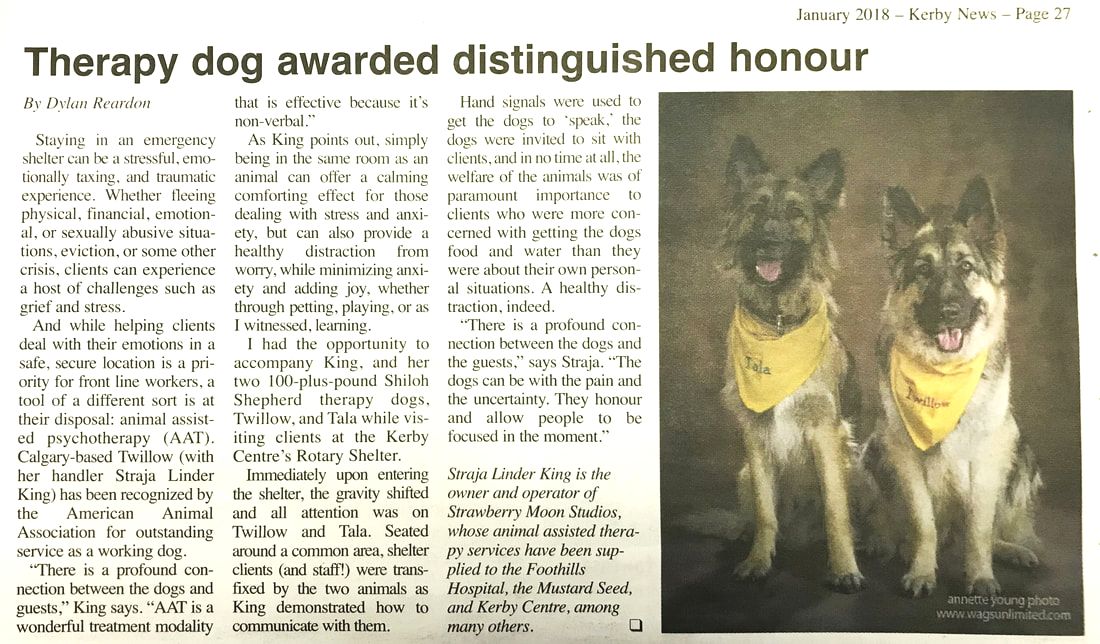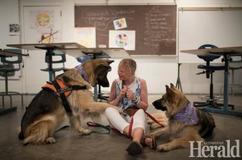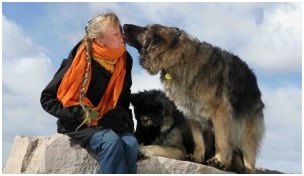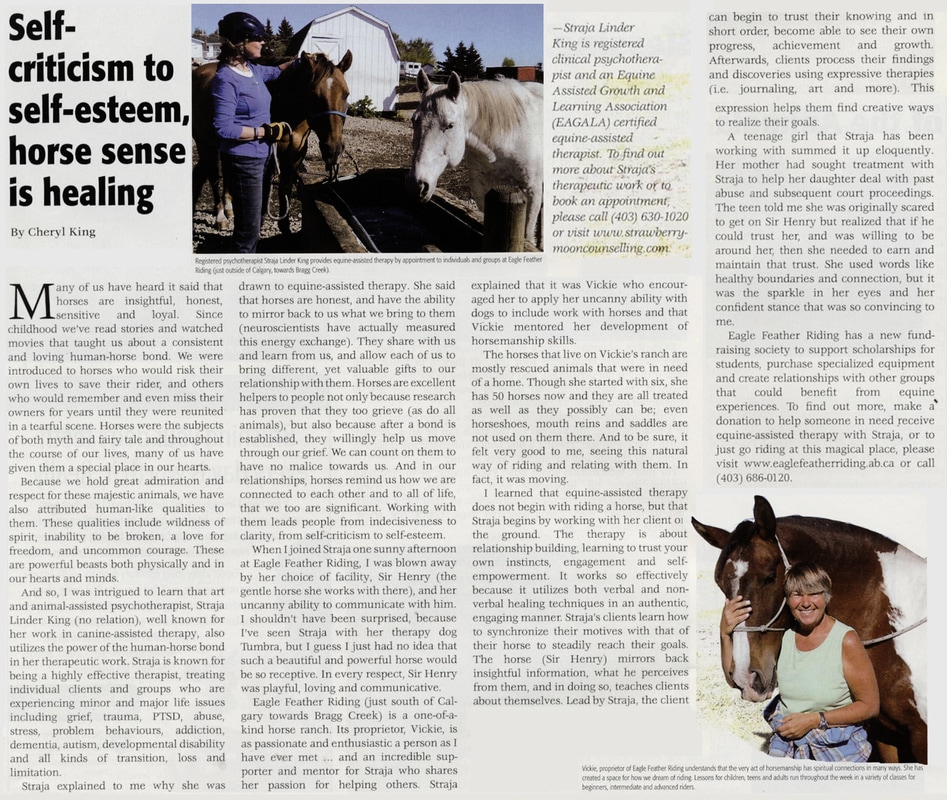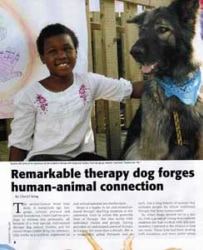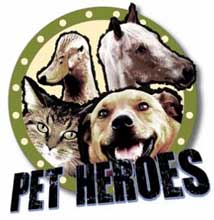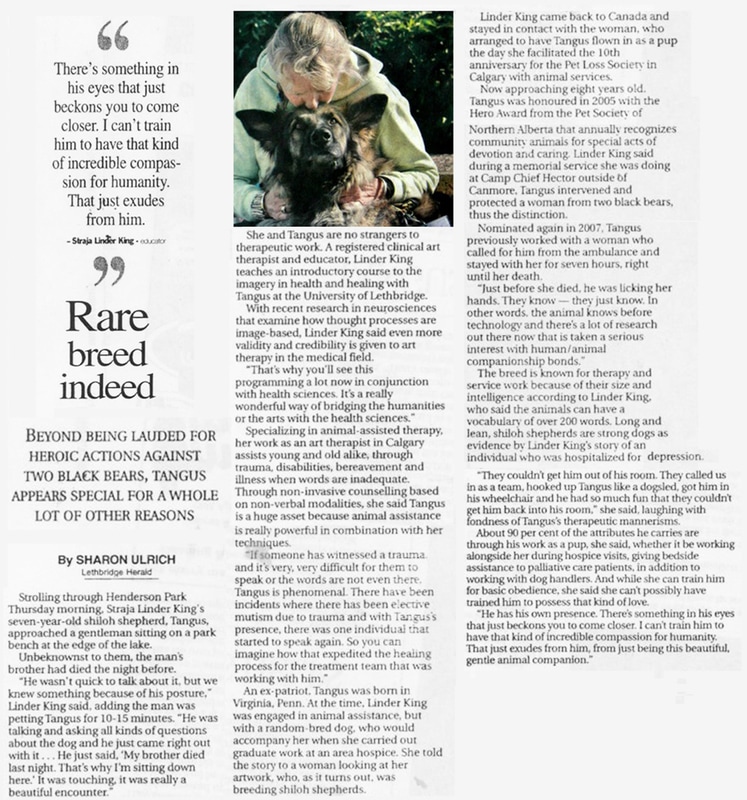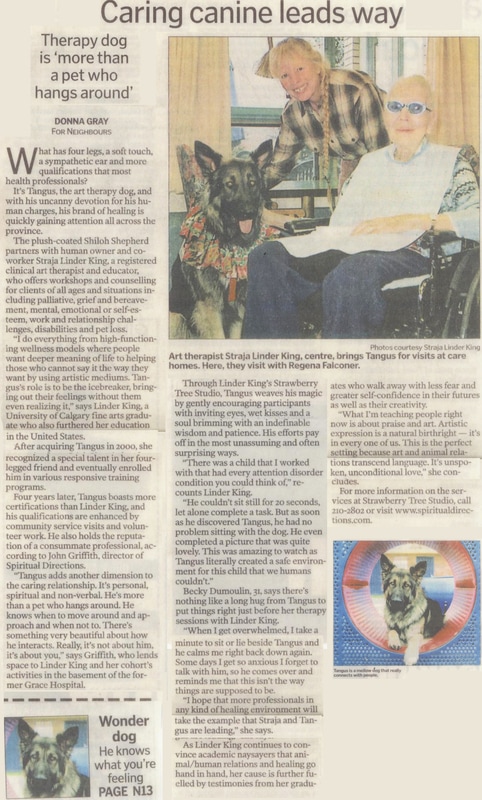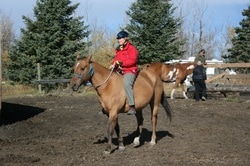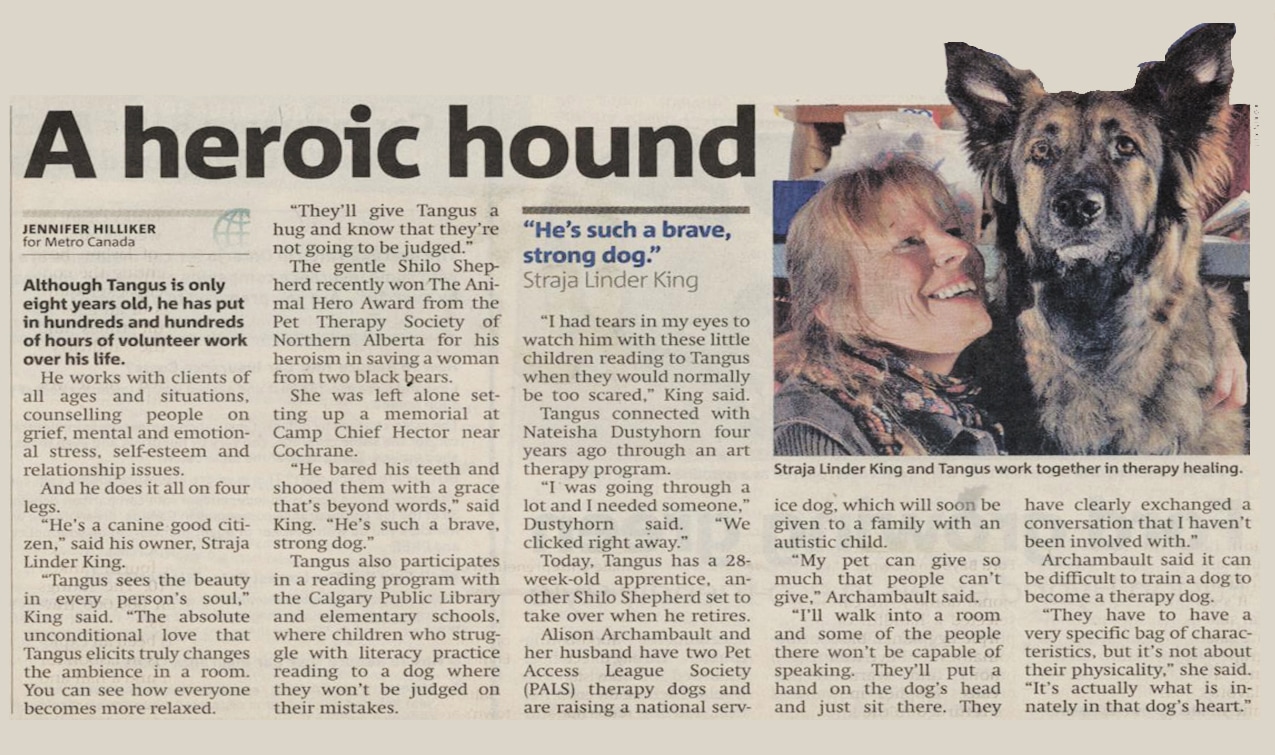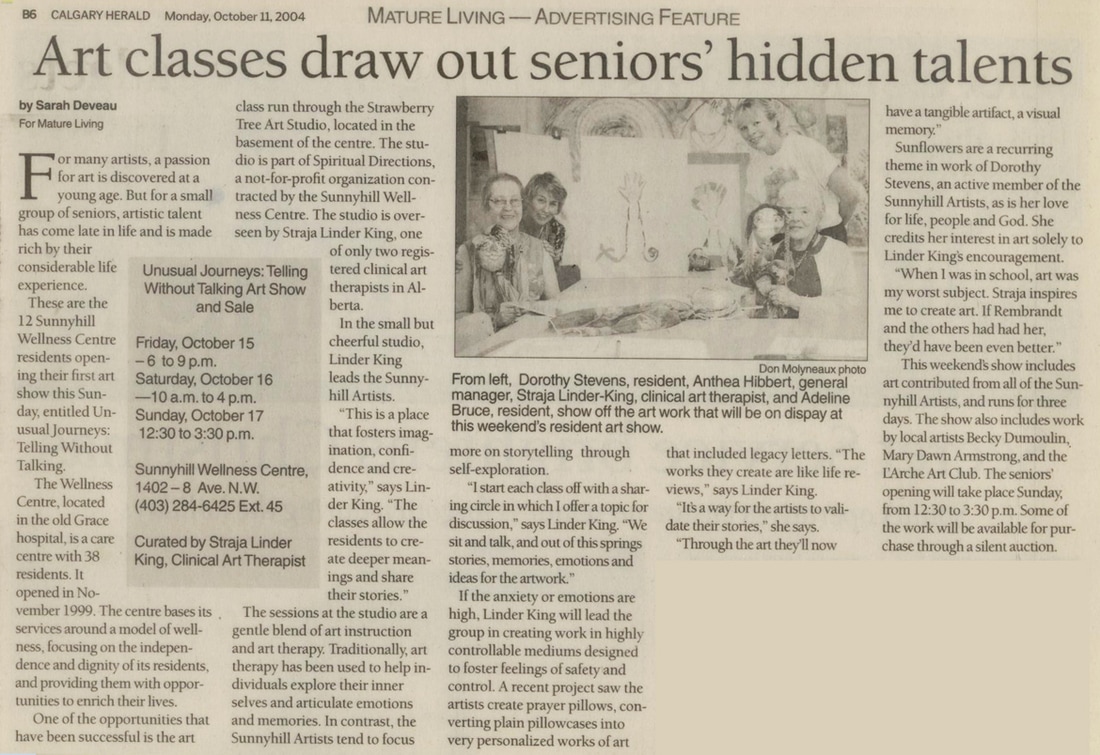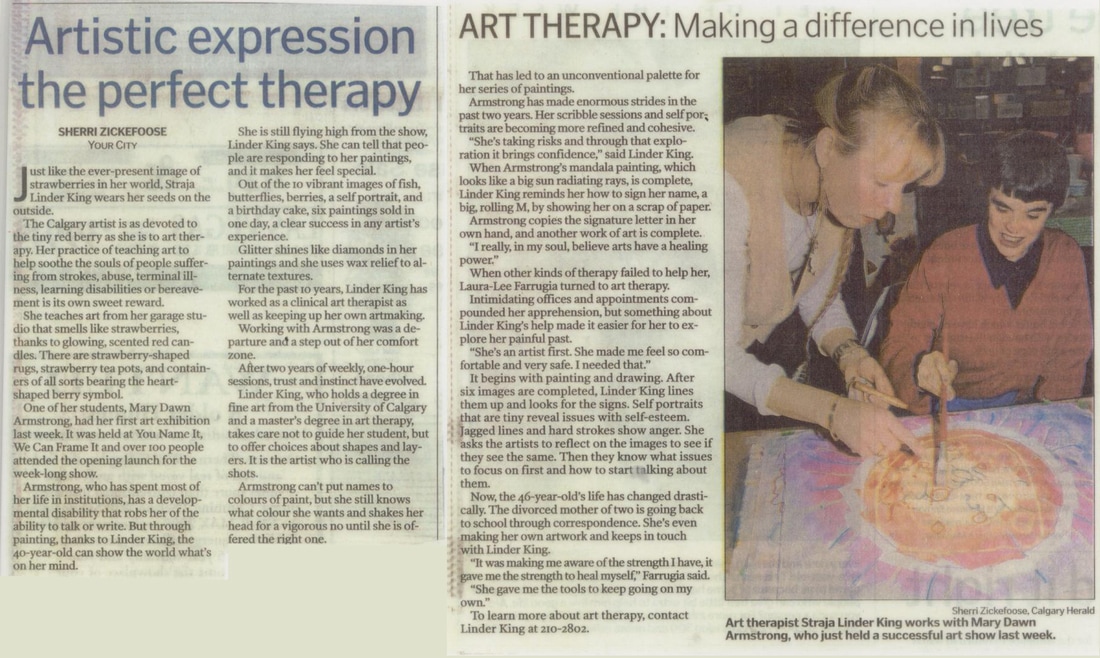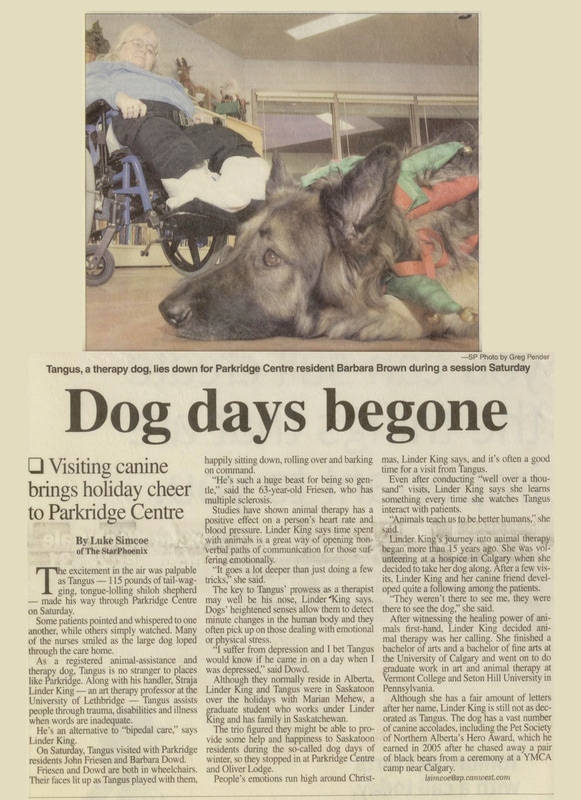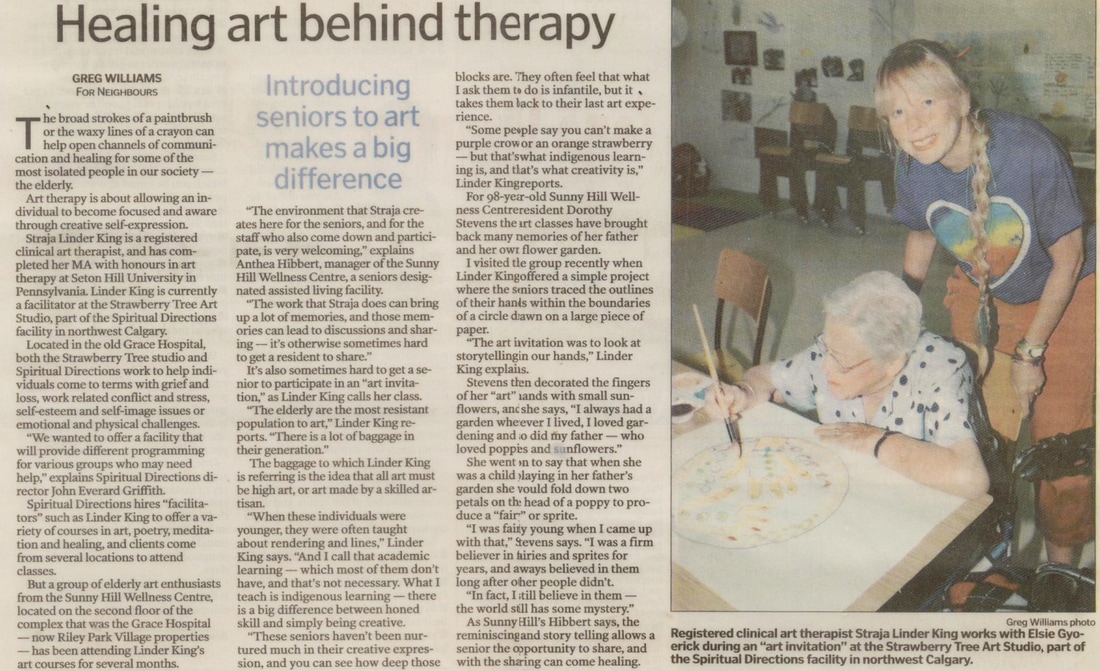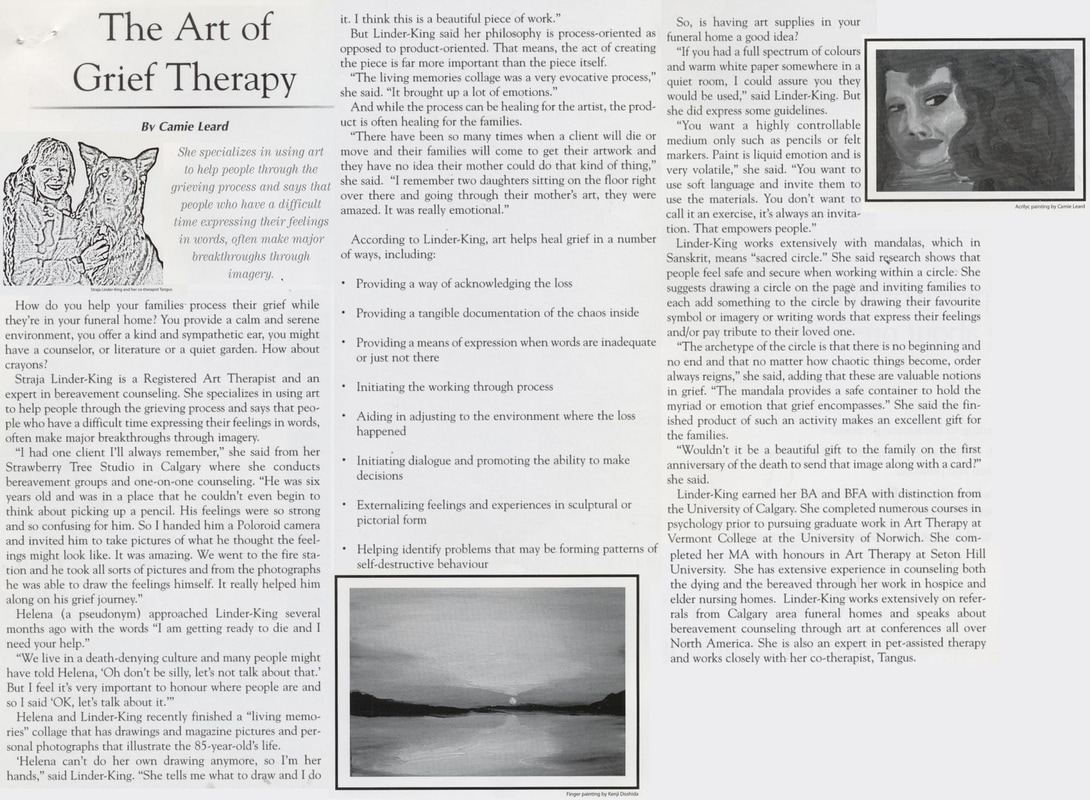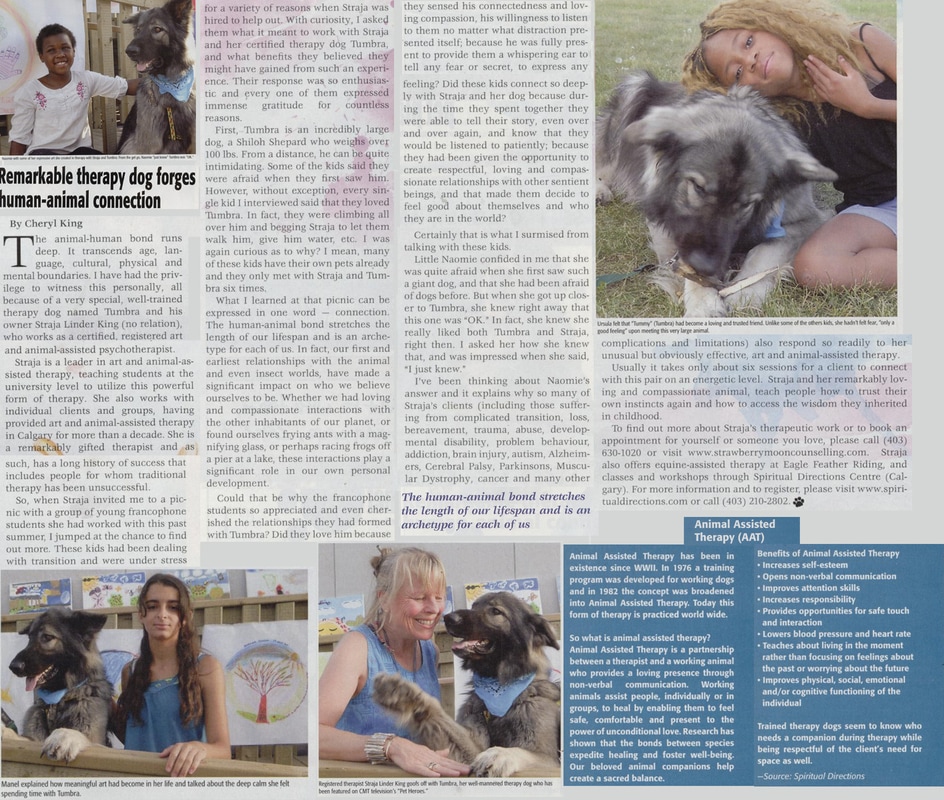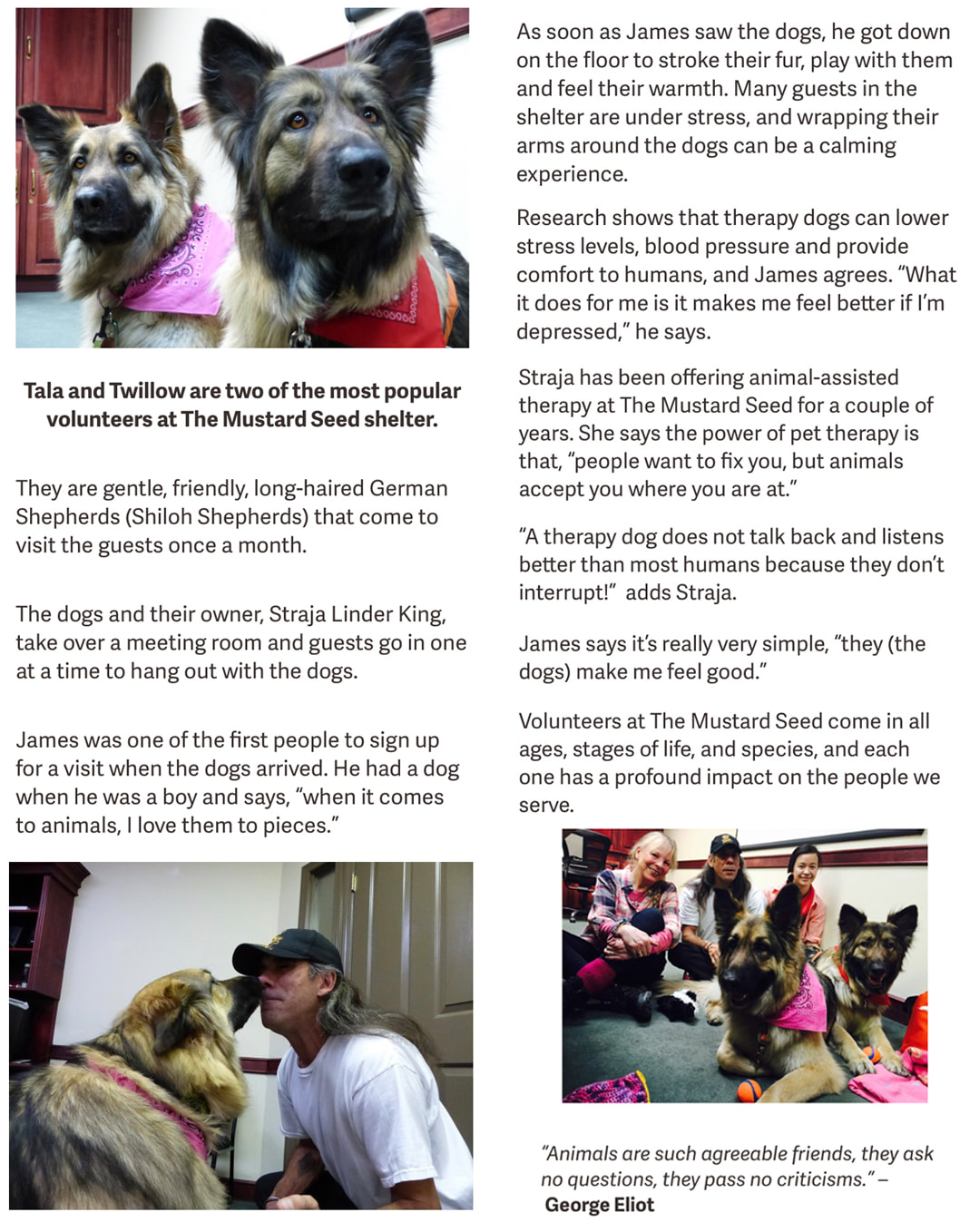aNIMALS AS CARETAKERS
January 18, 2017 “That is the nicest thing that anyone has ever done for me… ” These barely audible words issued forth as weak as frail branches in autumn trying to hold the heaviness of first snowfall. Words delivered from an 84 year-old gentleman in hospice where I was doing animal-assisted therapy (AAT) merged with clinical art therapy (AT) at the request of the patient’s family.
Therapy dogs are utmost a calming and comforting agent known to mitigate the anxiety and fear surrounding death and dying. Current research and media have proven over and over the beauty and efficacy of engaging therapy animals at end of life:
- Therapy dogs provide a healthy distraction from worry and create calming effects.
- Therapy dogs minimize anxiety while adding joyfulness whether petting or merely being in the presence of the animal.
- Therapy dogs have the ability to lower a patient’s blood pressure and heart rate.
- Therapy dogs mitigate worry and provide comfort.
- Many patients are reminded of their own wonderful experiences throughout life (reminiscence) surrounding animal companions.
Human animal bonds are ancient – much older than words. Seeing and the image also come before words. Animal-assisted art therapy provides a synergistic combination highlighting the power of the non-verbal, presence, and relationship. Art making brings us into relationship with the unique attributes of media, with the image itself and into the present moment of making. Our animal companions and therapy animals provide the same three qualities with one added incredible dimension, unconditional love.
Animal-Assisted Therapy (AAT) is the coined phrase that is becoming more popular as the research pours into mainstream health literature and programs. I witness the healing power of animals daily with my certified and registered therapy dogs, Twillow Rose and Tala Rain. These two therapy dogs facilitate a safe haven around patients and family members that allows everyone simply to be present to all the feelings at any given moment. People are talented at masking their deeper feelings. That is not necessary with therapy dogs present. They have an incredible ability to “be with” whatever we are experiencing. Dogs will not take our sadness away and are willing to be with it as we work our way through the darker emotions.
Therapy dogs, Twillow Rose and Tala Rain, assist people both physically and psychologically. In my work as a clinical art therapist, I specialize in animal-assisted art therapy (AAT/AT). When words are not easily expressed or sometimes not even present, Twillow and Tala are incredible and professional assistants. They assist me in helping clients navigate their feelings non-verbally in a safe environment. Therapy dogs can help us with this notion whether in a group setting or individual visits. Therapy dogs, Twillow and Tala epitomize the relational heart of human animal bonds. Who can help us face the mystery and fear of dying? Animals. Animals do not demonstrate fear of mortality. In a mostly death phobic culture we need the raw presence and deep unconditional love of animals and nature.
Straja Linder King
Authors’ Biography
Straja Linder King, MA, ATR-BC, is a Board Certified Registered Clinical Art Therapist currently teaching at the University of Lethbridge, Alberta, Canada and holds a private practice at the Strawberry Moon Studio. Linder King is a printmaker, published poet/author and Animal-Assisted (AAT) (AAAT) © specialist. She has been designing art therapy programs, workshops and presentations both nationally and internationally for over 15 years. She holds a Master’s degree in Art Therapy and two bachelor degrees both ‘with Distinction’ in Fine Arts and Art History from the University of Calgary. Linder King has pioneered art in healing from a spiritual/nature-based perspective in Alberta, Canada and does innovative work in health sciences, special education and gerontology.
The sorrow and grief surrounding the death of a pet
Staring out the window of my cottage-like art studio, I am invited to a sensory feast of sounds and sights. A crow squawks, a jet roars on the celestial highway above while flocks of geese bark out commands overhead. The day is warm and teeming with life. We are at winter’s end. Bravely, I slide the window even further to breathe in the clarity of the clear blue sky. The window becomes an interactive canvas inviting me to a private viewing. What do I see?
I see a constant interplay of beginnings and endings. Myriad stories unfold and shift, viewing life through this portal to the outside world. On the left hand side of the window an empty bird’s nest sways precariously on the limb of the cherry tree. Across the yard, tangled branches shadow dance in the energetic winds and shifting light on my neighbour’s wall. On the cedar fence post a sassy magpie vies for the attention of my three dogs playing in the yard. Here as I sit staring out the window, I witness life and death comfortably entwined.
Birth and death are present always. Loss is inevitable yet we do not get the call to attention until the death impacts us directly. The death of a pet, a powerful call, impacts us with immediacy and full intensity. The death of a loving pet irrevocably changes us forever. The loss means one less family member and the pain can be debilitating. Put simply, grief is a broken heart. The absence of our beloved friend alters our home and hearts forever.
After working in pet bereavement for over two decades, I can clearly state that no two losses are alike. Grief is unique as one’s fingerprint. From the moment that death occurs we feel a heaviness that defies description. Grief and gravity combined are unbearable to hold. No recipe will circumvent or eradicate the pain due to the death of a beloved animal companion. The grieving process unfolds on its own volition and there are no short cuts. Ignoring or minimizing this grief falls into the category of disenfranchised grieving. What does this mean?
“Disenfranchised grief” means there is an existing social stigma to this type of death and the grieving process surrounding the loss. Depending on the bond, the death of an animal companion can wound our soul with the same intensity and magnitude as the grief we feel for a human death. Research demonstrates that the grief experienced due to pet loss can actually be higher than that of human loss. Even if the pet has only been in our lives for a short while. This is due to the relationship, proximity, and deep bonds created with our beloved pet.
When we adopt, rescue, or add animal companions to our family we are well aware that their life span will most likely be shorter than ours. However, this knowledge does little to lessen the pain of pet loss. Our head holds the logic about our longevity not being the same as our pets, yet our heart contains the feelings experienced together in our relationship with them. Hence, when people minimize or disregard the animal’s death the grief intensifies. The term for this exacerbated grief is known as “disenfranchised”, making the bereavement journey all the more difficult.
Therefore, validation is vital in assisting those experiencing the death of an animal companion. “Disenfranchised” best describes this type of grieving when the validation is lacking. For example saying: “It is only a pet,” and “You can always get another,” is hurtful and wounding to the soul. This thinking still exists and as a society, many are still not willing to honour this type of grief. An animal companion can never be replaced anymore than a lost human life and “getting another” sounds like restocking our fridge with depleted items. Our pets are members of the family too.
With the death of a pet many people live in the shadow of their grief. This merely exacerbates the grieving process. When time is not taken away from our work to allow for working through the loss, then emotions become bottled up. All this stems from the fear of embarrassment in sharing what they are feeling. When you hear co-workers respond with: “It’s just a dog, you can get another,” or “Thank goodness it was only an animal,” there is not much to say. This response simply perpetuates the stigma leaving the bereaved feeling isolated and filled with despair. No one should grieve alone.
Grief houses myriad responses, complicating the grieving process. The complexities may stem from a variety of sources such as unexpected deaths, witnessing a traumatic event, or feeling solely responsible for the death. Reactions to these types of complications affect us at every level — physical, emotional, spiritual, and social. We all grieve differently and we need to companion and support one another on the journey experienced due to loss.
We are evolving with sensitivity to this unspoken grief. Thankfully, I have lived to witness the journey of seeing the changes evolve. I will always remember the horrific experience of taking my therapy dog to a local animal hospital. My dog was undergoing many tests due to the mystery surrounding constant weight loss. He was not doing well. One morning we had to take him in unexpectedly as he was hardly moving. They weighed him on the scales and quickly escorted the three of us into the nearest examination room.
Sitting with deep fear in our hearts we gently stroked the fur of our handsome big boy waiting for the doctor to enter. The door to our room was left ajar. While we sat in dread of the “not knowing” the fate of our beautiful pet, another vet walked by. Stuffed under one of her arms was a limp but alive small dog and as she walked by our open room she irritatingly exclaimed, “I have another euthanization and need someone to help me in the back.” Upon witnessing this event, both of our hearts filled with terror at the thought of our community therapy dog receiving the same death sentence on that cold morning. How insensitive and careless in not thinking about others in the nearby rooms. Needless to say we never went back to that clinic again. Thank goodness our sensitivity has grown exponentially over the past decade. We want dignity for our pets facing end of life challenges.
Many veterinarians now include a quiet room where patients may wait the outcome of their injured or sick pet’s future. One clinic here in the city designed its new quarters to incorporate a quiet room for animals facing end of life. There are two doors so you need not go through the waiting room once you check in and are ready to see the doctor. This fosters dignity and displays sensitivity to meeting the needs of the pets and their guardians. You are invited to take your pet’s favourite toy and blanket to make your animal companion as comfortable as possible. Being in a home-like room is calming when you are already in distress. I have been blessed to experience this with two of my animal companions and having a quiet room was extremely helpful.
And some veterinarians make house calls in order that the pet is as comfortable as possible. Also, this allows the entire family to be involved and creates a ceremonial area right in their home. This also facilitates children or other pets being able to witness the pet’s end of life if they wish. There are many ways to create rituals and ceremony to commemorate your pet depending on the circumstances. Having these options available allows you to be aware of the many avenues to explore prior to an emergency. This knowledge will surely mitigate some of the anxiety when faced with emergencies and end of life situations with your beloved animal. We all can contribute and carry this sentient wisdom in assisting those experiencing the loss of a partnership that fosters happiness and loving kindness. Our animal companions deserve this dignity.
—Straja Linder King is a board-certified clinical art therapist and clinical animal-assisted art therapist. She practices at her Strawberry Moon studio with certified therapy dogs, Twillow Rose and Tala Rain. Visit www.strawberrymooncounselling.com for more info.
I see a constant interplay of beginnings and endings. Myriad stories unfold and shift, viewing life through this portal to the outside world. On the left hand side of the window an empty bird’s nest sways precariously on the limb of the cherry tree. Across the yard, tangled branches shadow dance in the energetic winds and shifting light on my neighbour’s wall. On the cedar fence post a sassy magpie vies for the attention of my three dogs playing in the yard. Here as I sit staring out the window, I witness life and death comfortably entwined.
Birth and death are present always. Loss is inevitable yet we do not get the call to attention until the death impacts us directly. The death of a pet, a powerful call, impacts us with immediacy and full intensity. The death of a loving pet irrevocably changes us forever. The loss means one less family member and the pain can be debilitating. Put simply, grief is a broken heart. The absence of our beloved friend alters our home and hearts forever.
After working in pet bereavement for over two decades, I can clearly state that no two losses are alike. Grief is unique as one’s fingerprint. From the moment that death occurs we feel a heaviness that defies description. Grief and gravity combined are unbearable to hold. No recipe will circumvent or eradicate the pain due to the death of a beloved animal companion. The grieving process unfolds on its own volition and there are no short cuts. Ignoring or minimizing this grief falls into the category of disenfranchised grieving. What does this mean?
“Disenfranchised grief” means there is an existing social stigma to this type of death and the grieving process surrounding the loss. Depending on the bond, the death of an animal companion can wound our soul with the same intensity and magnitude as the grief we feel for a human death. Research demonstrates that the grief experienced due to pet loss can actually be higher than that of human loss. Even if the pet has only been in our lives for a short while. This is due to the relationship, proximity, and deep bonds created with our beloved pet.
When we adopt, rescue, or add animal companions to our family we are well aware that their life span will most likely be shorter than ours. However, this knowledge does little to lessen the pain of pet loss. Our head holds the logic about our longevity not being the same as our pets, yet our heart contains the feelings experienced together in our relationship with them. Hence, when people minimize or disregard the animal’s death the grief intensifies. The term for this exacerbated grief is known as “disenfranchised”, making the bereavement journey all the more difficult.
Therefore, validation is vital in assisting those experiencing the death of an animal companion. “Disenfranchised” best describes this type of grieving when the validation is lacking. For example saying: “It is only a pet,” and “You can always get another,” is hurtful and wounding to the soul. This thinking still exists and as a society, many are still not willing to honour this type of grief. An animal companion can never be replaced anymore than a lost human life and “getting another” sounds like restocking our fridge with depleted items. Our pets are members of the family too.
With the death of a pet many people live in the shadow of their grief. This merely exacerbates the grieving process. When time is not taken away from our work to allow for working through the loss, then emotions become bottled up. All this stems from the fear of embarrassment in sharing what they are feeling. When you hear co-workers respond with: “It’s just a dog, you can get another,” or “Thank goodness it was only an animal,” there is not much to say. This response simply perpetuates the stigma leaving the bereaved feeling isolated and filled with despair. No one should grieve alone.
Grief houses myriad responses, complicating the grieving process. The complexities may stem from a variety of sources such as unexpected deaths, witnessing a traumatic event, or feeling solely responsible for the death. Reactions to these types of complications affect us at every level — physical, emotional, spiritual, and social. We all grieve differently and we need to companion and support one another on the journey experienced due to loss.
We are evolving with sensitivity to this unspoken grief. Thankfully, I have lived to witness the journey of seeing the changes evolve. I will always remember the horrific experience of taking my therapy dog to a local animal hospital. My dog was undergoing many tests due to the mystery surrounding constant weight loss. He was not doing well. One morning we had to take him in unexpectedly as he was hardly moving. They weighed him on the scales and quickly escorted the three of us into the nearest examination room.
Sitting with deep fear in our hearts we gently stroked the fur of our handsome big boy waiting for the doctor to enter. The door to our room was left ajar. While we sat in dread of the “not knowing” the fate of our beautiful pet, another vet walked by. Stuffed under one of her arms was a limp but alive small dog and as she walked by our open room she irritatingly exclaimed, “I have another euthanization and need someone to help me in the back.” Upon witnessing this event, both of our hearts filled with terror at the thought of our community therapy dog receiving the same death sentence on that cold morning. How insensitive and careless in not thinking about others in the nearby rooms. Needless to say we never went back to that clinic again. Thank goodness our sensitivity has grown exponentially over the past decade. We want dignity for our pets facing end of life challenges.
Many veterinarians now include a quiet room where patients may wait the outcome of their injured or sick pet’s future. One clinic here in the city designed its new quarters to incorporate a quiet room for animals facing end of life. There are two doors so you need not go through the waiting room once you check in and are ready to see the doctor. This fosters dignity and displays sensitivity to meeting the needs of the pets and their guardians. You are invited to take your pet’s favourite toy and blanket to make your animal companion as comfortable as possible. Being in a home-like room is calming when you are already in distress. I have been blessed to experience this with two of my animal companions and having a quiet room was extremely helpful.
And some veterinarians make house calls in order that the pet is as comfortable as possible. Also, this allows the entire family to be involved and creates a ceremonial area right in their home. This also facilitates children or other pets being able to witness the pet’s end of life if they wish. There are many ways to create rituals and ceremony to commemorate your pet depending on the circumstances. Having these options available allows you to be aware of the many avenues to explore prior to an emergency. This knowledge will surely mitigate some of the anxiety when faced with emergencies and end of life situations with your beloved animal. We all can contribute and carry this sentient wisdom in assisting those experiencing the loss of a partnership that fosters happiness and loving kindness. Our animal companions deserve this dignity.
—Straja Linder King is a board-certified clinical art therapist and clinical animal-assisted art therapist. She practices at her Strawberry Moon studio with certified therapy dogs, Twillow Rose and Tala Rain. Visit www.strawberrymooncounselling.com for more info.
Making a PAWsitive Impact
The Mustard Seed News Fall 2013
|
Life on the streets or in a shelter can be overwhelming and full of worry, and healthy methods of relieving stress can be hard to find. For some of our guests, all of these worries seem to come to a halt when Straja Linder King, a Registered Animal-Assistance Therapist, brings her two incredible Shiloh Shepherd therapy dogs, Twillow and Tala, to The Mustard Seed Foothills Shelter. Straja volunteers her time once a month to facilitate animal therapy sessions where guests interact with these specially trained dogs who have been proven to increase serotonin levels (also known as the “happy chemical”).“There is a profound connection with the dogs and the guests,” says Straja. “The dogs can be with the pain and the uncertainty. They honour and allow people to be focused on the moment.”
A guest of The Mustard Seed named Troy benefits from this profound connection. He is allergic to dogs, but this does not deter him from signing up to spend time with Twillow and Tala every time they come to visit. “These dogs are awesome. They make me feel so great and smart,” he says while grinning from ear to ear as Twillow gives him kisses on the cheek. Afterwards, Troy says he will be itchy and sneezing all night, but the happiness they bring him outweighs the annoyance of his allergies. The human-animal bond is evident when you witness how these dogs lift the spirits of our guests. |
Animal assisted therapy
Lupus Courier Annual Newsletter
|
“That is the nicest thing that anyone has ever done for me…” these barely audible words issued forth as weak as frail branches in autumn trying to hold the heaviness of first snowfall. Words delivered from an 84 year‐old gentleman bed ridden in the hospital where I was assigned pet therapy at the request of another patient. A twenty year‐old patient along with his family requested a visit from my two young therapy dogs named Twillow Rose and Tala Rain. And who was the other man? Well, the 84 year‐old gentleman just happened to be the young man’s roommate. This intergenerational match‐up was not planned and some gifts simply unfold that way. The nurse on duty removed the young man including all equipmen tethered to him. Together they made their journey safely to the quiet room to meet the therapy dogs. In the small quiet room the young man, his mother, the dogs, staff, and our working team all engaged in the pet therapy session. I should add that after our being in that designated space they may need to change the name. The quiet room was no longer quiet and sounded more like a crowd viewing a spectacular fireworks display with each trick completed by Twillow Rose and Tala Rain. Oh the joyful giggles and laughter. Of course the dogs lapped this up like their chicken broth at dinnertime. Did I mention that dogs smile? Well they do smile when they are working together and especially when onlookers cheer them through their repertoire. Afterwards, the head nurse of the unit begged us to please consider doing one more super quick visit with the dogs. This unplanned visit ended up giving us the greatest rewards. Imagine the joy that surfaced from this elderly man being surrounded by more than two hundred pounds of exuberance and wild tail wagging. Endless kisses and wet noses circling his bed. What joy to observe the aforementioned words found in the first sentence from this 84 year‐old patient. This is the power of human animal bonds or “pet therapy”. Pet therapy or Animal‐Assisted Therapy ( AAT) is the coined phrase that is becoming more popular as the research pours into mainstream health literature and programs. I witness the healing power of animals daily with my two certified and fully registered therapy dogs, Twillow Rose and Tala Rain ( CGN/TDI). These two gentle giants foster loving kindness and teach us through the gentle elements of play. Along with their compassionate ways one of the dog’s greatest gifts is their ability to simply be with the myriad of emotions at any given time. Dogs remain in the temporal state of presence. This allows them to actively engage and be with each and every emotions as they surface and unfold. Please make note that Twillow Rose and Tala Rain do NOT rescue, mask or fix anything. Well then what do they do you might ask? Therapy dogs facilitate a safe haven around them that allows us to simply be present to what we are feeling at any precise moment. They work in REAL time too. People are talented at masking their deeper feelings. That is not necessary with therapy dogs present. They have an incredible ability to “be with” whatever we are experiencing. Dogs are wonderful companions and deliver good medicine….the adage of “pet two dogs and call me in the morning” is funny and accurate. Dogs will not take our sadness away. Therapy dogs are comfortable and willing to simply be present to the sadness. And they are so attentive and patient while we work our way through the darker emotions.This authenticity or being “with our pain” is what pet therapy is about. Therapy dogs remain at our side enabling us to work through the “hard to talk” about emotions and unpleasant feelings. Feelings that are not serving our highest good and causing us unwanted stress. This is the alchemy of pet therapy. Ongoing research demonstrates how the bonds between human/animal species expedites healing and fosters well‐being. Both in research studies and in my own clinical work with clients, many of whom experience high blood pressure, the inclusion of animals has been shown to lower heart rate as well as reduce blood pressure. Our beloved animal companions help create a sacred balance. This sacred balance is living harmoniously, relaxed, and purely makes us feel better. Major benefits of animal assisted therapy ( AAT) are the animal’s ability to mitigate our anxiety while bolstering our happy hormones such as oxytocin and endorphins. All this without even having to touch them! Yes that is right …you merely need be in their wondrous presence to soak up their humour, and loveable antics. All combined to easily add sunshine to the dreariest of days. Their unconditional love and joy can light up the darkest corners. Twillow Rose and Tala Rain assist people both physically and psychologically. In my work as a clinical art therapist, I specialize in animal‐assisted art therapy ( AAT/AT). When words are not easily expressed or sometimes not even present, Twillow and Tala are incredible and professional assistants. They assist me in helping clients navigate their feelings non‐verbally. A good example is grief. Grieving clients are kept in the present moment and can feel safe with the presence of Twillow and Tala at their side.Therapy dogs create a safe environment that allows the client to safely address each and every emotion as they unfold. As humans we can easily turn reflecting on the past to regret and turn uncertainty of the future into worry. Both are not helpful knowing that all we really ever have at any given time is the present moment. Therapy dogs are a gentle reminder of how vital being present can be on our wellness journey. Therapy dogs can help us with this notion whether in a group setting or individual visits.When working with groups or individually, both Twillow and Tala have an uncanny ability to know who needs their attention most. These warm canine companions have a built in heart tracker and instinctively go to those needing their healing affections most. You cannot train a dog to like people. When the dogs are puppies they go through numerous testing to see if they demonstrate a propensity for their therapy work. Then the actual training starts from that point and continues throughout their life span. This is the beauty of a working bond.We have an inherent need to be connected with all life. This need is termed “Biophilia” from the Greek words for life (bio) and for loving (phil). This is not about sentimentality; it is a core recognition that all humans have a biologically based bond to the more than human world.
“Until one has loved an animal… a part of one’s soul remains unawakened.” Anatole France
“Until one has loved an animal… a part of one’s soul remains unawakened.” Anatole France
Remarkable Therapy Dog Forges Human-Animal Connection
Citizen Pet - Fall 2011
|
Lending a Helping Paw
The Calgary Journal - August 2011 |
CMT Television's Pet Hero
CMT Television's "Pet Heroes" Television Show - April 2011.Straja's certified therapy dogs, Tangus and Tumbra were profiled as real-life heroes on the CMT television show "Pet Heroes". The internationally broadcasted show profiled both of Straja's well-trained, well-mannered canines for their outstanding contribution to her therapeutic work and for their many hours of volunteerism in the community. Tangus even helped save someone from being attacked by two black bears... the showed aired as the final episode of the 2011 season.
Visit the CMT Pet Heroes Website Video clip currently unavailable because it is still airing on CMT "Pet Heroes" |
Recognition from the Community
|
Volunteer Animal of the Year, Leadership Calgary Award - Tangus was nominated in 2010.
Volunteer Animal of the Year, Leadership Calgary Award - Tangus received the award in 2009 (Photo). Keep in mind that he didn't drive himself to volunteer all over our community. Heart of the Hero Award - Tangus was recognized by the Pet Therapy Society of Northern Alberta in October 2005. |
Caring Canine Leads Way
Radio Interview with Straja Linder King
|
Blog Talk Radio
Straja talks about animal-assisted therapy Listen to Straja's interview on the BlogTalkRadio website |
Spiritual Directors International talks with Straja Linder King
Watch this brief video of Straja's interview on the Spiritual Directors Website
Telling without talking



